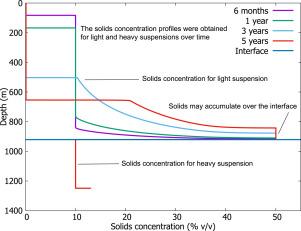Continuum model for the numerical simulation of the sedimentation process of two immiscible non-Newtonian suspensions confined in an annulus
IF 4.6
2区 工程技术
Q2 ENGINEERING, CHEMICAL
引用次数: 0
Abstract
The sedimentation process in a single suspension was broadly studied in many previous works. In the annular region of oil wells, the presence of the drilling fluid is common, which contains solid particles acting as a weighting agent. Additionally, there is a second confined fluid, known as a washer, that has the function of avoiding contamination of cement paste by the drilling fluid. The washer is heavier than the drilling fluid and may also have solid particles in its composition. The batch sedimentation of two immiscible suspensions is yet now well known. Here we employed a continuum model for the sedimentation in one suspension, which was previously validated with experiments and was able to obtain the solids concentration profile over time. We extended the model to the case with two immiscible fluids. The domain was discretized using the finite volume method. The problem was evaluated at a real well scale. The results showed that the presence of the second fluid may significantly alter the sedimentation process of the light suspension and depend on the fluid base type, as well as the difference in the suspensions’ properties. Formation of sediment may be observed above the interface between the suspensions, depending on the heavy suspension rheology and solids concentration. The rheological parameters had a key role in the process. Also, we studied the cases with different temperature conditions, as the model may account for the temperature effect locally in the rheological behavior of the suspensions.

连续体模型的数值模拟沉降过程的两个不混相非牛顿悬浮物限制在一个环空
在以往的许多工作中,对单一悬浮液中的沉降过程进行了广泛的研究。在油井的环空区域,钻井液的存在是常见的,其中含有作为加重剂的固体颗粒。此外,还有一种被称为清洗剂的密闭流体,它具有避免钻井液污染水泥浆的功能。垫圈比钻井液重,并且在其组成中也可能含有固体颗粒。两种不混溶悬浮液的间歇沉降现在已为人所熟知。在这里,我们采用了一个连续体模型来研究一种悬浮液中的沉降,该模型之前已经通过实验验证,并且能够获得随时间变化的固体浓度分布。我们将模型推广到两种不混相流体的情况。采用有限体积法对区域进行离散化处理。该问题在实际井规模下进行了评估。结果表明,第二流体的存在会显著改变轻悬浮液的沉降过程,这取决于流体基型以及悬浮液性质的差异。根据重悬浮液的流变性和固体浓度,在悬浮液之间的界面上方可以观察到沉积物的形成。流变参数在该过程中起着关键作用。此外,我们还研究了不同温度条件下的情况,因为该模型可以局部考虑温度对悬浮液流变行为的影响。
本文章由计算机程序翻译,如有差异,请以英文原文为准。
求助全文
约1分钟内获得全文
求助全文
来源期刊

Powder Technology
工程技术-工程:化工
CiteScore
9.90
自引率
15.40%
发文量
1047
审稿时长
46 days
期刊介绍:
Powder Technology is an International Journal on the Science and Technology of Wet and Dry Particulate Systems. Powder Technology publishes papers on all aspects of the formation of particles and their characterisation and on the study of systems containing particulate solids. No limitation is imposed on the size of the particles, which may range from nanometre scale, as in pigments or aerosols, to that of mined or quarried materials. The following list of topics is not intended to be comprehensive, but rather to indicate typical subjects which fall within the scope of the journal's interests:
Formation and synthesis of particles by precipitation and other methods.
Modification of particles by agglomeration, coating, comminution and attrition.
Characterisation of the size, shape, surface area, pore structure and strength of particles and agglomerates (including the origins and effects of inter particle forces).
Packing, failure, flow and permeability of assemblies of particles.
Particle-particle interactions and suspension rheology.
Handling and processing operations such as slurry flow, fluidization, pneumatic conveying.
Interactions between particles and their environment, including delivery of particulate products to the body.
Applications of particle technology in production of pharmaceuticals, chemicals, foods, pigments, structural, and functional materials and in environmental and energy related matters.
For materials-oriented contributions we are looking for articles revealing the effect of particle/powder characteristics (size, morphology and composition, in that order) on material performance or functionality and, ideally, comparison to any industrial standard.
 求助内容:
求助内容: 应助结果提醒方式:
应助结果提醒方式:


